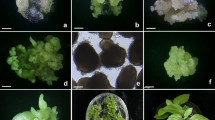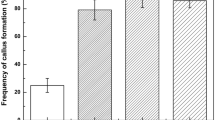Summary
Suspension cultures which maintained embryogenic potency for more than 18 months were established from excised immature embryos of rice (Oryza sativa L. cv. Konansou). The cultures were subcultured every three days in N6 medium supplemented with proline (10 mM), casein hydrolysate (300 mg/l), sucrose (30 g/l) and 2,4-D (1 mg/l). The frequency of embryogenesis from the embryogenetic suspension cultures reached about 90% when cell clusters (about 1 mm in diameter) were transferred to a solid medium which consisted of N6 medium, NAA (1 mg/l), kinetin (5 mg/l), sucrose (30 g/l) and Gelrite (2 g/l). When smaller clusters of cells (approximately 200–400 μm in diameter) were transferred to a liquid medium which consisted of salts of N6 medium diluted with an equal volume of water plus sucrose (45 g/l), NAA (0.01 mg/l) and 4-PU (0.1 mg/l) at a cell density of 13 clusters/ml in 2 ml of medium, somatic embryogenesis was initated at high frequency (about 50%). Morphological evidence is provided to demonstrate that the regeneration occurred via embryogenesis. This is the first report of high-frequency embryogenesis in suspension cultures of rice cells.
Similar content being viewed by others
References
Abe T, Futsuhara Y (1985) Efficient plant regeneration by somatic embryogenesis from root callus tissues of rice (Oryza sativa). J Plant Physiol 121:111–118
Armstrong CL, Green CE (1985) Establishment and maintenance of friable and embryogenic maize callus and the involvement of l-proline. Planta 164:207–214
Bhattacharya P, Sen SK (1980) Potentiality of leaf sheath cells for regeneration of rice (Oryza sativa) plants. Theor Appl Genet 58:87–90
Chandler SF, Vasil IK (1984) Optimization of plant regeneration from long term embryogenic callus cultures of Pennisetum purpureum schum. (Napier grass). J Plant Physiol 117:147–156
Chen TH, Lam L, Chen SH (1985) Somatic embryogenesis and plant regeneration from cultured young inflorescences of Oryza sativa L. (rice). Plant Cell Tissue Organ Cult 4:51–54
Chu CC, Wang CC, Sun CS, Hsu C, Yin KC, Chu CY, Bi FY (1975) Establishment of an efficient medium for anther culture of rice through comparative experiments on the nitrogen sources. Sci Sin 18:659–668
Duncan DR (1985) The production of callus capable of plant regeneration from immature embryos of numerous Zea mays genotypes. Planta 165:322–332
Green CE (1982) Somatic embryogenesis and plant regeneration from the friable callus of Zea mays. In: Fujiwara (eds) Plant Tissue Culture. Maruzen, Tokyo, pp 107–108
Inoue M, Maeda E (1980) Thiamine as a factor of organ formation in rice callus cultures. Jpn J Crop Sci 49:1–7
Kawata S, Ishihara A (1968) The regeneration of rice plant, Oryza sativa L., in the callus derived from the seminal root. Proc Jpn Acad 44:549–553
Ling DH, Chen WY, Ma ZR (1983) Somatic embryogenesis and plant regeneration in an interspecific hybrid of Oryza. Plant Cell Rep 2:169–171
Lu C, Vasil IK (1985) Histology of somatic embryogenesis in Panicum maximum (Guinea grass). Am J Bot 72(12): 1908–1913
Maeda E (1968) Subculture and organ formation in the callus derived from rice embryos in vitro. Proc Crop Sci Soc Jpn 37:51–58
Murashige T, Skoog F (1962) A revised medium for rapid growth and bioassays with tabacco tissue cultures. Physiol Plant 15:473–497
Niizeki H, Oono K (1968) Induction of haploid rice plant from anther culture. Proc Jpn Acad 44:554–557
Nishi T, Yamada Y, Takahashi E (1968) Organ redifferentiation and plant restoration in rice callus. Nature 219:508–509
Ozias-Akins P, Vasil IK (1982) Plant regeneration from cultured immature embryos and inflorescences of Triticum aestivum L. (wheat): evidence for somatic embryogenesis. Protoplasma 110:95–105
Peck DE, Cumming BG (1986) Beneficial effects of activated charcoal on bulblet production in tissue cultures of Muscari armeniacum. Plant Cell Tissue Organ Cult 6:9–14
Raghava-Ram NV, Nabors MW (1985) Plant regeneration from tissue cultures of pokkali rice is promoted by optimizing callus to medium volume ratio by a medium-conditioning factor produced by embryogenic callus. Plant Cell Tissue Organ Cult 4:241–248
Sozinov A, Lukjanjuk S, Ignatova S (1981) Anther cultivation and induction of haploid plants in triticale, Z Pflanzenphysiol 86:272–285
Tamura S (1968) Shoot formation in calli originated from rice embryo. Proc Jpn Acad 44:544–548
Trigiano RN, Conger BV (1987) Regulation of growth and somatic embryogenesis by proline and serine in suspension cultures of Dactylis glomerata. J Plant Physiol 130:49–55
Vasil V, Vasil IK (1980) Isolation and culture of cereal protoplasts. II. Embryogenesis and plantlet formation from protoplasts of Pennisetum americanum. Theor Appl Genet 56:97–99
Vasil V, Vasil IK (1981a) Somatic embryogenesis and plant regeneration from tissue cultures of Pennisetum americanum and P. americanum x P. purpureum hybrid. Am J Bot 68:864–872
Vasil V, Vasil IK (1981b) Somatic embryogenesis and plant regeneration from suspension cultures of pearl millet (Pennisetum americanum). Ann Bot 47:669–678
Vasil V, Vasil IK (1985a) Induction and maintenance of embryogenic callus cultures of Graminae. In: Vasil IK (eds) Cell Culture and Somatic Cell Genetics of Plants. Academic Press, Orlando, pp 36–42
Vasil V, Vasil IK (1985b) Isolation and maintenance of embryogenic cell suspension cultures of gramineae. In: Vasil IK (ed) Cell Culture and Somatic Cell Genetics of Plants. Academic Press, Orlando, pp. 152–157
Vasil V, Vasil IK (1986) Plant regeneration from friable embryogenic callus and cell suspension cultures of Zea mays L. J Plant Physiol 124:399–408
Vasil V, Lu C, Vasil IK (1985) Histiology of somatic embryogenesis in cultured immature embryos of maize (Zea mays L.). Protoplasma 127:1–8
Wernicke W, Brettell R (1980) Somatic embryogenesis from Sorghum bicolor leaves. Nature 287:138–139
Wernicke W, Brettell R, Wakizuma T, Potrykus (1981) Adventitious embryoid and root formation from rice leaves. Z Pflanzenphysiol 103:361–365
Author information
Authors and Affiliations
Additional information
Communicated by Hu Han
Rights and permissions
About this article
Cite this article
Ozawa, K., Komamine, A. Establishment of a system of high-frequency embryogenesis from long-term cell suspension cultures of rice (Oryza sativa L.). Theoret. Appl. Genetics 77, 205–211 (1989). https://doi.org/10.1007/BF00266188
Received:
Accepted:
Issue Date:
DOI: https://doi.org/10.1007/BF00266188




